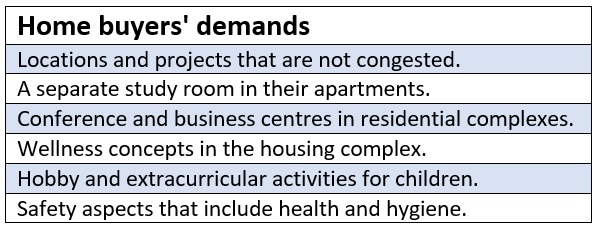[ecis2016.org] According to an online poll by Track2Realty, home buyers are not looking for knee-jerk design changes but for long-term functional changes in housing projects, after the Coronavirus pandemic
An impression is gaining ground that developers have realised that the world has changed due to the Coronavirus pandemic and that they need to alter their products, to fit the buyers’ needs. However, home buyers have never been consulted in the past and they probably will not be consulted, even in a post-COVID-19 world. Track2Realty asked home buyers to define their wish-list, vis-à-vis new houses. Are they really looking for standalone villas, or would they still prefer homes in the city centres, with design changes that could offer better liveability. Here’s a look at the top 10 design and functional changes that the Indians are asking for:
You are reading: Coronavirus impact: Home buyers seek long-term functional changes in home design
Proximity to the workplace is no longer crucial
Central Business Districts (CBDs) will no longer command as high a premium as it used to. More than eight out of 10 (82%) Indians are ready to travel some distance, if the quality of life is better at a location that is at a travelling distance. The fear of living in congested locations, is a big deterrent for future home buyers.
Buyers want a separate study room
As many as 78% home buyers feel that a separate study room is a must, in the new world after COVID-19, if work from home has to be a feasible idea. Most of them (70%), are even ready to compromise on the size of the bedrooms and living room, to ensure that the carpet area is not increased and the cost of the apartment does not escalate.
Business centres in residential complexes
What was earlier considered as a luxury, meant only for premium apartment complexes, is today in the necessity wish-list of two-thirds of the home buyers. 68% demand that a separate business centre has to be an integral part of the housing apartments, where they can book the facility for work and conferencing and also entertain business guests. Clubs within the societies need to have lounges as well and 42% are even ready for a paid service for the same.
Read also : 10 Tallest Commercial Buildings Of The World

Villas at periphery locations are not practical
More than half the home buyers (54%) feel that having a villa at the outskirts of the city, rather than an apartment in the centre of the city, is a fancy idea but not practical. These home buyers cite commuting challenges, since a complete ‘work from home’ is not possible. Moreover, economic considerations are as important, as physical and social infrastructure and these home buyers feel that the peripheral locations fail miserably on this front. Loneliness and depression were also cited by as many as 60% home buyers, as the reason why they would prefer an apartment over a standalone house.
Wellness as a concept to gain ground
The Coronavirus pandemic has changed the thought process of Indians, to the extent that 64% buyers are ready to compromise with some of the amenities, to get a wellness concept interwoven into the housing project. Some form of connection with nature, would attract as many as 80% of the home buyers in the post-COVID-19 world.
Children’s play area not sufficient
The future home buyers will not be impressed with facilities like skating rink, badminton court, tennis court, etc., for the children’s play area. Their idea of children activities, for as many as 80%, is way beyond that and includes hobby and extracurricular activities within the housing complex. The safety aspect of the children is no more related to law and order but also with health and hygiene.
Facilities beyond basic amenities
More than half the home buyers, as many as 52%, also demand full-scale retail facilities at the housing projects, including cafeteria and restaurants. Four out of 10 even expect the developers to introduce facilities for concierge services within the complex. 60% expect the houses to introduce no-touch smart home automation and no-touch elevators. Focus is more on automation, than the physical presence of guards.
Read also : West Tambaram property market: An overview
Social housing as a concept, has not yet gained ground. Indians have traditionally relied on domestic help, drivers, etc., to travel to housing complexes from nearby clusters. However, the lockdown and absence of these essential services, have forced nearly half the Indians (48%), to accept the need for housing within the complexes, for support staff. The demand is greater in upscale societies.
More space within the apartment
Indian urban cities are known for their cramped apartments. Following the COVID-19 pandemic, 78% of home buyers are looking for more open spaces within the apartment, like balconies and vertical gardens and are open to the idea of compromising a bit of the carpet area for the same.
Design changes do not require additional super area
A vast majority of Indians surveyed in the poll, as many as 84%, believe that these functional changes and design elements, do not require one to shell out more money in the form of additional super built-up area. They maintain that the time has come, for innovative design and architecture, where non-usable areas, such as large entrance lobbies, can be done away with.
(The writer is CEO, Track2Realty)
Source: https://ecis2016.org/.
Copyright belongs to: ecis2016.org
Source: https://ecis2016.org
Category: Lifestyle





